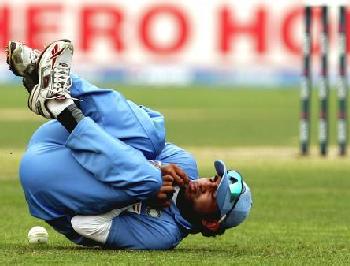7 questions you should ask while choosing a gym
What image does the word gym conjure up for you?
A hi-tech, confusing torture chamber filled with beautiful bodies?
A sawdust covered floor where massive muscle marys are taking turns to swap pumping iron and pumping steroids?
Perhaps.
Or maybe its somewhere that you can get fit for cricket. You already know that I think a gym is an essential place for almost all cricketers, so what is the ideal gym for cricketers to go to?
How important is the gym?
I'm a pretty lucky bloke.
Because I have always had access to a gym as a sports student, fitness instructor or employee, I have always been able to improve my fitness for cricket.
I have sort of taken it as a given that every cricketer and coach agrees with me.
They don't though.
Can bad fielders hide?

It's a perennial problem from Test cricket to club level: What do you do with the folks that cant run, throw or catch?
The issue has kept Monty Panesar from the England ODI side and keeps chunky middle-aged blokes in the slips for years. But its a problem that club captains can overcome.
The answer is this: put them in places the cricket ball is unlikely to go. Not much of a secret then. But the real mastery to this trick is to do it subtly, so the opposition doesn't realise what you are up to. So instead of putting your rabbit at mid on automatically, consider these options.
A few notes on field placing
If you are a captain or bowler the chances are that you agonise over setting the right field.
While the wrong field can be a disaster, the right one can make the difference between winning and losing. Especially in lower scoring games. So mastering the basics is essential. As is being able to think on your feet and change your ideas and plots at a moments notice. Perhaps even every ball.
With that in mind, here are some general notes on how to place the field.
The top 6 cricket gurus
Mike Brearley, the greatest England captain, once wondered why cricketers did not turn to people they trusted to advise them more. Perhaps its the individual nature of the game that makes players feel alone? But whatever the reason, Brearley advocated the use of a guru you trust to help you get to where you want to go.
Weekly Links 10th September 2006
- I have taken the plunge into Myspace and added a profile. Its a big scary place so if you are on there then make sure you give me some support.
- A new cricket game called Cricket Life is knocking around. It looks different from the usual strategy game, but is it any good?
- Lots of cricket sport science references from the Australian Institute of Sport.
Build a diet you can be proud of
We already know that eating in the right way is good for your cricket and good for your health.
How do the facts we have learned translate into what we eat?
Nutritional aims
10 Tips on drinking for cricket players

- Water is vital to cricket. Even 1% dehydration can cause a marked reduction in performance.
- To combat dehydration, cricketers should drink between 1-3 litres during the day (the hotter it is the more you drink)
The only 6 foods you need for cricket
It's becoming increasingly difficult to keep up with food. Where do you start if you want to eat right for cricket? Low carb? Low GI? Beverly Hills? Cabbage Soup?
The secret is a lot simpler than weighing out your baked beans and obsessively checking the labels on everything. I'll come to that in a moment, but first a little bit of background.
Why is nutrition important for cricket?

A leisurely summer tea of cucumber sandwiches and cream cakes is an enduring image of cricket in England and shows how deep the link between club cricket and nutrition goes.
But cricket teas, lunches and drinks prepared by the vicar's wife are more than just age old traditions. The body has a basic need for food for survival and has a specific need for food to play cricket.

